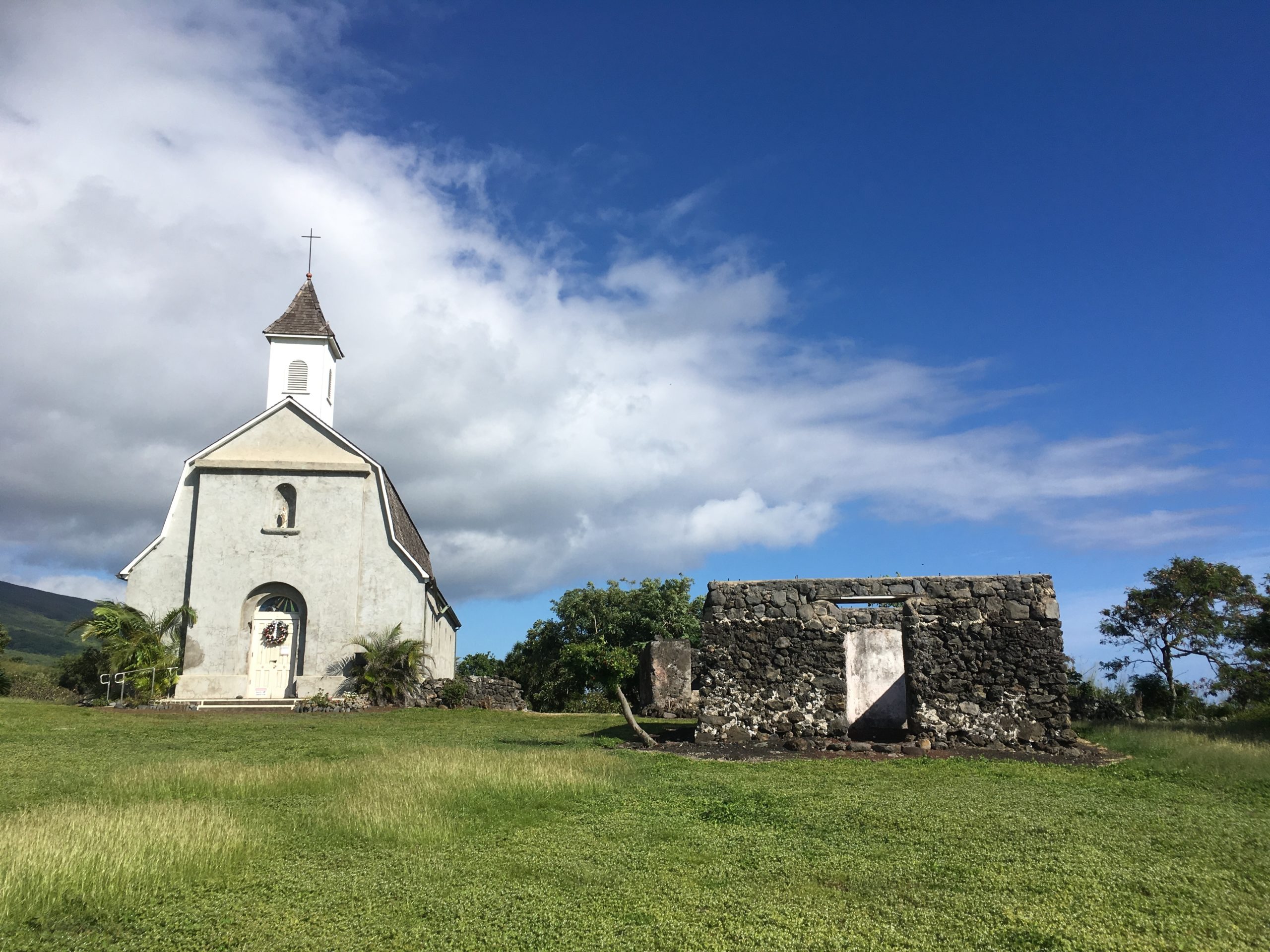
Hawaii History & Civilization Growth
The Hawaiian islands are the most isolated landmass on earth. The earliest archaeological evidence shows some carbon dated fish hooks on the Big Island dating back to 450 AD but most historians believe the classic Hawaiian civilization did not begin to develop until nearly 700 years later.
Hawai’i has many mysteries about its ancient past and the evolution of the landscape and culture. Hawaiian legends speak of several waves of immigration from multiple southern islands in ancient Polynesia. Through modern archeology we have learned much about these migrations and the steady rise in population, religion and the cultural practices that these ancient voyagers brought to the Hawaiian Island group.
In The Beginning
The Distant Past
Scientists now believe that nearly 5000 years ago an early Asiatic civilization came into contact with Central American civilizations for a cultural revolution across the Pacific. The appearance of fabrics in Peru about 2500 B.C. is evidence of the cultivation of cotton, an Asian plant, which scientist speculate was carried across the Pacific.
Other plants known in Hawaii during ancient times are from central America and Asia. These include sweet potatoes and hibiscus. The various endemic Hawaiian hibiscus, including the state flower, are considered to be an Asiatic plant (possibly from Madagascar or southern tropical China) and are biologically adapted to several Hawaiian Islands.
Also an “Andean” connection to Hawai’i is suspected by some due to a Central American poppy and the sweet potato, which suggests the Hawaiian Islands may have been a halfway staging point for an ancient people maintaining voyaging contact between Asia and the northwest coast of South America.
Growth Of The Ancient Population
The oral traditions of tracking genealogies in ancient Hawai’i was extensively studied by Abraham Fornander, the director of Bishop Museum in Honolulu during the mid 1800’s. Fornander relied on native accounts which suggested that by 1865 there had been 28 generations of Hawaiian royalty. Chronologically his estimates put the first settlement of the islands at around AD 965 – 1065. By the 1920’s radio carbon dating was invented and archaeologists began scouring the islands for samples to test. On the southern tip of the Big Island of Hawai’i is a large complex of ancient ruins called South Point. It was here in a low lying sand dune that hundreds of bone fishhooks were excavated and some were carbon dated to AD 450.
The legends of the Hawaiians were preserved with marvelous integrity. Their historians were the priests, who at intervals met in council and recited and compared their genealogical meles (chants), in order that nothing might be either changed or lost.
The Keanae Peninsula on Maui’s eastern coastline along the road to Hana is said to have been man made in ancient times with dirt hauled down from the valley above to create flat fertile farmland. This farmland of taro fields can still be seen today. It is one of the finest examples of ancient Hawaiian ingenuity to be found in the islands.
Similar testing around Haleakala’s shorelines, especially the Kahikinui area on the Kaupo side and the Kipahulu area located in Haleakala National Park’s eastern perimeter near Hana, produced dates closer to AD 1000. This doesn’t necessarily mean Polynesians were not on Maui earlier, it’s just that there has been little evidence found to date showing established settlements within an earlier timeframe.
Polynesian Migrations To Haw
Archaeologists today believe that multiple migrations back and forth between the southern Polynesian islands (known as the Polynesian Triangle) resulted in these carbon dating variances. Most scholars now believe the Hawaiian archipelago became completely isolated sometime around the 13th century. It is theorized that possible changes to the northwestern Hawaiian island chain (loss of atolls used to hop scotch across the ocean) made it difficult to return to this part of the pacific.
At the close of the second migratory period, which concluded their travels with the world beyond them for more than six hundred years, or from a.d. 1175 to 1778, the people of the Hawaiian island group had, for the most part, transferred their allegiance to the newly-arrived chiefs. The notable exceptions were the Maweke and Kamauaua families of Oahu and Molokai, both of the ancient Nanaula line. Although they were gradually crowded from their possessions by their more energetic invaders, the high genealogical rank of the native chiefs was recognized and by intermarriage their blood was allowed to mingle with the royal bloodlines of the newly arrived southern Polynesians.
Population estimates vary widely and are hard to verify but new artifact dating techniques have helped establish a more accurate estimate in recent years. Patrick Vinton Kirch – author & Professor of Anthropology at UC Berkeley has been excavating ancient ruins on Maui’s dry southeastern side for close to 50 years.
The moku (district) of Kahikinui & Kaupo along Maui’s dry southeastern side is known to be the largest intact ruins of an ancient Hawaiian society in the state. It has been untouched by development since it was abandoned in 1895 (due to cattle ranching) by a once substantial native population. Professor Kirch has surmised a population estimate based on the number of ancient hale (houses) and heiau (temples).
Professor Kirch also references a census taken by missionaries in 1832 after 40 years of foreign diseases had decimated an estimated 80% of the native population. Using the known average number of persons living in an ancient kua hale (housing complex) of between 6 and 8 individuals as well as researching accounts by early explorers, he has come up with a population estimate of between 200,000 and 250,000 native Hawaiians living on Maui by the mid 1700’s.
This population, along with the mobility afforded by the “King’s Road” encircling the island, made Maui one of the most powerful islands in the group. For nearly 200 years Maui’s alliances were formed (usually through marriage) with the Big Island, Molokai, Lanai, Oahu and Kauai.
By the mid 1700’s Maui’s king Kahekili II would set the stage for Kamehameha’s war by bringing all the islands under his control except for the Big Island. The irony of it all is that Kahekili had an affair with a Big Island princes who was none other than Kamehameha’s mother. Many suspect Kahekili, sworn enemy of the Big Islands king Kalaniopu’u and his nephew Kamehameha, may have very well been Kamehameha’s father!
Developmental Periods Of The Hawaiian Society
An Ancient Chronology
Archeologist like Patrick Kirch, studying the polynesians across the Pacific, have determined the Hawaiian Islands were settled in ancient times during 5 main periods of discovery and growth:
Foundation Period, A.D. 1000 – 1200: the first arrival of Polynesians and initial settlement in the most favorable zones of the island. Several waves of immigration starting from the Marquesas Islands and ending with peoples from Tahiti.
Early Expansion Period, A.D. 1200 – 1400: the end of voyaging contacts with central eastern Polynesia (Tahiti, Samoa, Tonga, Cook and Society Islands). Development of major irrigation based settlements.
Late Expansion Period, A.D. 1400 – 1650: population growth drives the expansion of settlements in the arid, leeward zones and upper dry-land forests of the islands.
Protohistoric Period, A.D. 1650 – 1778: the period of “classic” Hawaiian civilization with all island zones densely populated.
Post-Contact Period, A.D. 1778 to 1898 overthrow of the Hawaiian Kingdom: the period after the arrival of Captain James Cook. Sweeping cultural changes due to contact with the West; colonialism, missionaries and other western influences accelerate the de-construction of the Hawaiian religion and society which had stood for over 600 years. From 1810 to 1898 the Kingdom of Hawai’i will see a total of 8 monarchs rule the island chain.
The Land of Aloha
Extensive Voyaging Skills
Ancient polynesians where one of the most prolific voyaging societies on earth. Few societies in the world ventured out of sight of land in the first century A.D. but the polynesians had already populated most of the Pacific ocean spanning thousands of square miles of open ocean.
A Migratory Peoples
Multiple migrations to and from Hawaii brought plants and animals needed to sustain an ever increasing population. They arrived first from the Marquesas Islands with later waves of immigrants coming from Tahiti, Samoa, Tonga and the Society Islands.
Sustainable Agriculture
The Hawaiian land management system is fascinating in its intelligence and resourcefulness. It provided for all using land divisions running from the mountains to the sea. The early polynesians brought plants and animals with them. These “canoe plants” began the agricultural advances that eventually sustained a society estimated to be close to 1 million people by the 1700’s.
Todays Hawaiian Culture
Ancient Hawaiians quickly adapted to the influences of the western world. In less that 20 years the ancient warfare society evolved into a monarchy devoted to it’s people and the aina (land). Today the word Aloha is known the world over thanks to the Hawaiian people and their culture.
The Human Evolution Of The Hawaiian Islands
300 – 500
Polynesians from the South Pacific, probably the Marquesas Islands, begin migration to Hawaii in double-hulled voyaging canoes.
480
One of Hawaii’s first heiau (religious temples), “Mookini Luakini,” is built on the Big Island
850
Main Hawaiian Islands are widely yet thinly occupied. These interspersed villages are independently ruled but vulnerable to raids from more war like peoples migrating from the southern islands.
1100 – 1300
Tahitian explorers arrive, initiating a second wave of immigration which ends by around 1200 A.D; they subdue and in some instances inter-marry with the earlier inhabitants.
1400
The backbone of Hawaiian culture begins to emerge as social classes are established and the islanders split into tribes, adorning themselves with feathered capes, helmets and jewelry made from shells and human teeth.
1736 – 1758
Kamehameha the Great is born on the Kohala coast on the Big Island of Hawaii. According to Hawaiian astronomers of the time, a brilliant celestial star appeared in the sky the year of his birth (probably the 1758 return of Halley’s Comet).
1766
Kahekili becomes ruling chief of Maui. His royal complex is located at the mouth of Iao Valley in what is today Wailuku.
1768
Birth of Ka’ahumanu in Hana – future favorite wife of Kamehameha who would rule as Queen Regent along with Kamehameha’s oldest son Liholiho. She would usher in the abolishment of the kapu (taboo) system, bringing more freedom to the Hawaiian population. Hana is ruled by royalty (Ali’i) from the Big Island.
1778
Captain James Cook, British commander of HMS Resolution and HMS Discovery, sights Oahu and Kauai. Cook names them the “Sandwich Islands” after the Earl of Sandwich, first lord of the admiralty. He would make contact off shore of Maui with Kahekili (King of Maui) at Wailuku. A few days later he would meet Kalaniopu’u, King of Hawai’i Island, and his nephew Kamehameha offshore of Hana Maui.
1779
Captain James Cook makes landfall at Kealakekua Bay on Hawaii Island. At first he is welcomed as a god. This changes quickly though and items are stolen from the foreigners who retaliate by trying to detain King Kalaniopu’u. The native Hawaiians, protecting their king, kill Captain Cook in a skirmish on the beach.
1781
Birth of Kapiolani – future sacred wife of Kamehameha and mother of his successors. Kamehameha battles for control of the Big Island districts.
1782
Accession of Kamehameha.
1785
Kamehameha takes Ka’ahumanu for his wife. She encourages him on his conquest of bringing all the islands under the control of one ruler.
1787
Kaima, a local chieftain, sails with fur trader ship “Nootka” to China and North America. His return in 1788 encourages other Hawaiians to sign on to other ships.
1790
Battle of Ka’uwa’u-pali (Clawed off the cliff) & Ke-pani-wai (Damming of the Waters) in Maui’s Iao Valley. Kamehameha wins control of the island.
1795
Kamehameha defeats the last of Kahekili’s forces in O’ahu and consolidates his power over all the islands except Kauai. His fleet attempts to invade Kauai but is turned back by a storm.
1810
Kauai chiefs (Ali’i) recognize Kamehameha as Moi Nui (overall King) of the islands by ceding control of the island to his rule. Peace would now reign in Hawai’i after an estimated 100 years of war.
Maui History Books & References
*Moses Manu, The Story of Kihapiilani, Ka Nupepa Kuokoa, Aug. 9, 1884. MS SC Sterling
*S.M. Kamakau, Ruling Chiefs of Hawaii, Translated from the newspaper Ke Au Okoa 1961 SC Sterling
*Abraham Fornander, An Account of the Polynesian Race: Its Origins and Migrations London 1876-85
*Pi’opi’o State Park signage- Hilo, Hawaii – Kamehameha Schools Alumni Association, Mamalahoe Chapter
John F.G. Stokes – Curator of Bishop Museum Honolulu writing in the Hawaiian Historical Society publication of 1932
Abraham Fornander – Director of Bishop Museum publication -Origins of the Polynesian Race – 1880
Great Hawaiian timeline – http://www.mauimapp.com/moolelo/chronology.htm
Patrick Vinton Kirch – Author & Professor of Anthropology at UC Berkeley
Kua’aina Kahiko: Life and Land in Ancient Kahikinui, Maui
Maui a History – by Cummins E Speakman Jr and Jill Engledow
Shark Going Inland Is My Chief – Author Patrick Vinton Kirch
Unearthing the Polynesian Past: Explorations and Adventures of an Island Archaeologist
Feathers and Fishhooks – Author Patrick Vinton Kirch








